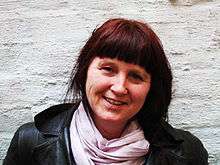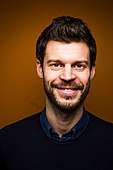Red Party (Norway)
The Red Party (Bokmål: Rødt, Nynorsk: Raudt, Northern Sami: Ruoksat) is a Norwegian political party. The party was founded in March 2007 by a merger of the Workers' Communist Party and the Red Electoral Alliance. Bjørnar Moxnes is the Red Party's current leader.
Red Party Rødt | |
|---|---|
 | |
| Leader | Bjørnar Moxnes |
| Founded | 11 March 2007 |
| Merger of | RV AKP (ML) |
| Headquarters | Dronningens Gate 22 Oslo |
| Youth wing | Red Youth |
| Membership (2019) | |
| Ideology | Democratic socialism[2] Revolutionary socialism[3] Communism[4] Eco-socialism[5] Feminism[6] Marxism[7] Hard Euroscepticism[8] Norwegian republicanism[9] |
| Political position | Left-wing[10][11][12][13] to far-left[14][15][16][17] |
| Colours | Red |
| Slogan | "Fordi fellesskap fungerer" ("Because community works") |
| Storting | 1 / 169 |
| County Councils | 20 / 574 |
| Municipal Councils | 193 / 9,344 |
| Website | |
| rødt.no | |
In its political program, Red sets the creation of a classless society to be its ultimate goal, which the party says is "what Karl Marx called communism".[18] The party's other goals are replacing capitalism with socialism, an expansive public sector and nationalization of large enterprises. It has a revolutionary socialist ideology, which aims towards new legislatures taking power on behalf of the workers.[3] However, the party does not support violent "armed revolution" as espoused by its predecessors in the 1970s and 1980s.[19]
The Red Party has 10 county council representatives nationwide and 80 municipal representatives. In the 2013 parliamentary election, it was the largest party which failed to win a seat. The party entered parliament in the 2017 election, winning 2.4% of the votes and its first seat ever in the Storting. The last time a far-left party had representation in the Storting was when its predecessor party, the Red Electoral Alliance, won a seat in the 1993 election.
Ideology and positions
The party favours the welfare state and high taxation upon the wealthy as a means of tackling continuing inequality in Norway.[20] Since its formation, notable groups have merged with the party, the most notable example of this being the Trotskyist International Socialists.[21] The party consists of various internal factions, including the Trotskyists, Marxist–Leninists, and democratic socialists.[22]
One of Red's important projects is protecting the Norwegian welfare state, calling for the government to spend 30-40 billion NOKs on the public sector to counter the financial crisis of 2007–2008.[23] Red politician Mimir Kristjansson claimed that the "right wing parties have proved their willingness to dismantle the very foundation of our welfare state". According to him, the socialist parties, along with the Norwegian Labour Party, need to be forced into a policy which strongly protects the welfare model for the poor.[24]
The 2009 election results, which were regarded as disappointing, led to some turmoil within the party, with some members wanting the party to move ideologically closer to the Socialist Left Party.[25]
After being challenged on the party's position on liberal democracy in 2012, party leader Moxnes wrote in Aftenposten that "free speech, freedom of association, free elections, free media, and independent courts that guarantee rule of law for individuals are fundamental for a socialist society".[26]
The continued mention of communism in the party program has been a hotly debated topic in the party, with much of the leadership, including Moxnes, wanting to abandon mention of the ideology in favor of a purely democratic socialist line. However, the party voted to remain ideologically committed to Marxist communism in 2014 and again in 2019.[27]
History
Formation
Red was founded on 7 March 2007 in a merger of the Red Electoral Alliance and the Workers' Communist Party. The two parties had shared the same history for decades, because the Workers' Communist Party founded the Red Electoral Alliance as an electoral party that would promote communist and socialist values. During the national convention held by the Red Electoral Alliance, a faction within the party stated it would support the merger of the two parties if any references to communism in the new party program would be removed.[28]
During a secret meeting between the leading staff of both parties on 5 March, a vote was held, with most members supporting the merger. The Workers' Communist Party was official dissolved in April 2007.[29] During the party's first national convention, three names were considered: Red Choice, Solidarity, and Red Cloth.[30] When founded, the party saw it as its main mission to fill "the void" between it and the Red-Green Coalition.[31] When talking about the party program, Torstein Dahle said:
We will bring up issues which have broad agreement among the people of Norway, but are unfortunately not reflected in the other parties' policies.[32]
Dahle (2007–2010)

Torstein Dahle was unanimously elected party leader by members of the Workers' Communist Party and the Red Electoral Alliance in February 2007.[33] This was met with criticism by outsiders, who claimed that Dahle would not be able to lead the party in a "new direction". The then leader of the Workers' Communist Party, Ingrid Baltzersen, was elected the party's Deputy Leader.[34]
On 23 July 2007, Dahle became subject to media attention when he said that the Taliban and other Afghan rebels had the full right to fight Norwegian soldiers stationed in Afghanistan.[35] The attention occurred only days later with the death of a Norwegian army officer in the Logar Province as a Norwegian military unit came under hostile fire. Dahle later replied to the criticism, saying that he did not support the death of Norwegian military personnel.[36]
When planning for the 2007 local elections, the party thought it had a realistic chance of gaining the mayorship in three municipalities. During the local elections, the party was forced to campaign under the banner of the Red Electoral Alliance, as the Election Committee had not approved its new name.[37]
Election researcher Bernt Aardal believed that Red would be able win votes from voters who usually voted for the Socialist Left Party. The reasoning behind this was that the Socialist Left became part of the ruling Red-Green Coalition, and would constantly need to make compromises with the two other parties in the coalition. When confronted with his research, he replied, "This is not a large voter group. We've looked at some polls in the past that RV would give the party one or two seats in Parliament. It is difficult to say whether the new party will make a difference."[38]
After experiencing what many described as a bad election, Trond Andresen, a leading political figure within the party, resigned. He claimed the party was going in a downward spiral and would meet the same fate as the Communist Party of Norway if it did not renew its image.[39] Among several known candidates that officially announced or were rumoured to be candidates for Party Leader were Bjørnar Moxnes,[40] Mona Bjørn,[41] Asgeir Drugli, Mimir Kristjansson, and Ingeborg Steinholt.[42]
Thomassen (2010–2012)

Turid Thomassen was voted in as party leader of Red in May 2010. Thomassen has long experience from both the Workers' Communist Party and the Red Electoral Alliance. The former leader of Red Youth (2004-2006), Bjørnar Moxnes, became deputy leader.
Moxnes (2012–present)
Bjørnar Moxnes was elected party leader in May 2012.
Youth programs

The party's youth wing is Red Youth, which was founded in 1963, preceding the foundations of the Red Electoral Alliance and the Workers' Communist Party. The current leader of the youth wing is Tobias Drevland Lund.[43] Red Youth was highly supportive of the merging of the Red Electoral Alliance and the Communist Party, with Sandra Johansen, leader of Red Youth in Brønnøysund, claiming "it to have been difficult to be a youth party under two different parent parties".[44]
Former Deputy Leader of the Red Electoral Alliance Marte Mjøs Persen left the party, believing there was a big generational gap between the older and younger members of Red. She further claimed that only the older members, who have their origins from the foundation of the Red Electoral Alliance and the Workers' Communist Party, controlled the party. Persen's statements were met with positive response by fellow party members and outsiders. Mathias Furevik, who had served as Dahle's campaign manager, agreed with her accusations. Bergen City Council representative, Stine Akre, reluctantly agreed with Persen's accusations, and said: "Red is now a party for middle-aged men, and has not been able to get rid of the generation gap. It also means that many younger people will get burned out before they move the party's direction."[45] Persen shortly after joined the Norwegian Labour Party.
Election history and polls
In the 2007 county election, Red won 2.1% of the votes.[46] After the 2007 county elections, Knut Henning Thygesen became the party's first and only mayor elected through a direct mayor election in the municipality of Risør.[47] In the local 2011 county elections, the party won 1.7% of the votes. In the 2009 parliamentary election, the result was 1.3%, giving the party no seats in the parliament. The party came closest to winning a seat in Oslo, where it took nearly 4% of the vote.[15]
Electoral researcher Bernt Aardal noted that the Red Party would have won a single seat in Oslo, had it not been for the fact that the voting system is designed to ensure that more MPs come from rural areas.[48] The Oslo constituency was considered to be where the party had its best chance of gaining a seat in the 2013 parliamentary election, but they once again failed to win any seats. In 2017, the party broke through in Oslo with party leader Moxnes being elected for the first time.
Electoral results
| Election year | # of overall votes |
% of overall vote |
# of overall seats won |
+/- |
|---|---|---|---|---|
| 2009 | 36,219 | 1.35 | 0 / 169 |
|
| 2013 | 30,751 | 1.08 | 0 / 169 |
|
| 2017 | 70,341 | 2.39 | 1 / 169 |
| Year | Vote % | Type |
|---|---|---|
| 2007 | 1.9 2.1 |
Municipal County |
| 2011 | 1.5 1.7 |
Municipal County |
| 2015 | 2.0 2.2 |
Municipal County |
| 2019 | 3.8 3.9 |
Municipal County |
Party leaders
| No. | Portrait | Leader | Took office | Left office | Time in office |
|---|---|---|---|---|---|
| 1 | Torstein Dahle | February 2007 | 30 May 2010 | 3 years, 118 days | |
| 2 | Turid Thomassen | 30 May 2010 | 6 May 2012 | 1 year, 342 days | |
| 3 | Bjørnar Moxnes | 6 May 2012 | Incumbent | 8 years, 101 days |
References
- NRK. "Rødt har doblet medlemstallet" (in Norwegian).CS1 maint: uses authors parameter (link)
- Red Party membership. "Demokrati". Rødt (in Norwegian).CS1 maint: uses authors parameter (link)
- Jan-Arve Overland, Inga Berntsen Rudi, Ragnhild Tønnessen. "Hva står de politiske partiene for?". Nasjonal digital læringsarena (in Norwegian).CS1 maint: uses authors parameter (link)
- Nordsieck, Wolfram (2017). "Norway". Parties and Elections in Europe. Retrieved 13 August 2018.
- Red Party membership. "Miljø". Rødt (in Norwegian).CS1 maint: uses authors parameter (link)
- Red Party membership. "Feminisme". Rødt (in Norwegian).CS1 maint: uses authors parameter (link)
- Solsvik, Terje; Knudsen, Camilla (23 August 2017). "Pick your kingmaker: small parties loom large in Norway's election". Reuters. Retrieved 24 June 2019.
- Fossum, John (4 February 2009). "Norway's European Conundrum" (PDF). Retrieved 24 June 2019.
- Monarki
- Björk, Tord (12 January 2019). "How Integrity Initiative and Atlantic Council is exposed in Norway". Steigan.no. Retrieved 24 June 2019.
- Youth Quotas and other Efficient Forms of Youth Participation in Ageing Societies. Chapter author - Petter Haakenstad (P.H.) Godli. Book edited by - Jörg Tremmel, Antony Mason, Petter Haakenstad Godli and Igor Dimitrijoski. P.169. Published in 2015. Published by Springer. Published in Oslo, Norway.
- "Norway - Political parties". Norsk Senter For Forskningsdata. Retrieved 24 June 2019.
- Fossum, John (4 February 2009). "Norway's European Conundrum" (PDF). Retrieved 24 June 2019.
- "Moxnes ny partileder i Rødt". NRK/NTB (in Norwegian). 6 May 2012.
- "Rødt". Store Norske Leksikon, 10 September 2013 (in Norwegian)
- "Rødts historie". TV 2. 19 February 2009.
- Kirk, Lisbeth (12 September 2017). "Norway populists secure second term in government". EUobserver. Retrieved 24 June 2019.
- "Rødt - Fordi fellesskap fungerer". xn--rdt-0na.no (in Norwegian Bokmål). Retrieved 4 January 2018.
- "Dropper væpnet revolusjon". Bergensavisen. 5 February 2007.
- Hellesnes, Pål (12 September 2009). "Dette står det om". Klassekampen (in Norwegian). p. 6.
- Aspevoll, Tone Foss (25 September 2007). "IS in i Rødt". Klassekampen (in Norwegian).
- Sjøli, Hans Petter; Bratlie, Tom Henning (4 April 2009). "Vil ha et liberalt Rødt". Klassekampen (in Norwegian). p. 11.
- Horn, Anders; Larsen, Christiane Jordheim (9 October 2009). "Noen må kreve mindre". Klassekampen (in Norwegian). p. 4.
- Larsen, Christiane Jordheim (23 September 2009). "Krever endring i Rødt". Klassekampen (in Norwegian). p. 4.
- Brox, Johan; Bratlie, Tom Henning (12 August 2009). "Rødt på vippen?". Klassekampen (in Norwegian). p. 8.
- Bjørnar Moxnes: Et sosialistisk folkestyre (in Norwegian) Aftenposten, 27 August 2012
- https://www.vg.no/nyheter/innenriks/i/4qWBzG/roedt-beholder-kommunisme
- "Et farvel til kommunismen?". Adresseavisen (in Norwegian). 12 February 2007. p. 11.
- "AKP og RV samles til helgen". Stavanger Aftenblad (in Norwegian). 6 March 2007. p. 13.
- "Rødt - rett og slett". Bergens Tidende (in Norwegian). 11 March 2007. p. 11.
- "Nytt parti på venstresida!". Dagsavisen (in Norwegian). 21 March 2007. p. 30.
- Nordstoga, Anders (7 March 2007). "Rødt skal fylle tomrommet på venstresiden". Aftenposten (in Norwegian). Archived from the original on 24 May 2011. Retrieved 15 December 2009.
- "På Topp: Torstein Dahle blir". Bergens Tidende (in Norwegian). 25 January 2007. p. 8.
- Lønna, Eline (24 January 2007). "RV-lederen vil lede nytt parti". Klassekampen (in Norwegian).
- Lecomte, Bjørn (23 July 2007). "Full rett til å kjempe mot NATO-soldater". Verdens Gang (in Norwegian). Retrieved 17 December 2009.
- Lecomte, Bjørn; Tommelstad, Bjørnar (23 July 2007). "Styrkene måtte skyte seg ut - Erfaren norsk offiser drept i Afghanistan". Verdens Gang (in Norwegian). Retrieved 17 December 2009.
- Mo, Helene (12 March 2007). "Rødt har ordførervyer". Dagsavisen (in Norwegian).
- Engan, Øyvind; Sørås, Trond (11 March 2007). "Partiet Rødt er født". Verdens Gang (in Norwegian). p. 7.
- Sjøli, Hans Petter (17 September 2009). "Det går som med NKP". Klassekampen (in Norwegian). p. 6.
- Skurdal, Mari; Larsen, Christiane Jordheim (18 September 2009). "Unge vil fram i Rødt". Klassekampen (in Norwegian). p. 6.
- "Generasjonsskifte". Klassekampen (in Norwegian). 21 September 2009. p. 4.
- Sjøli, Hans Petter (21 September 2009). "Sikter mot ledervervet". Klassekampen (in Norwegian). p. 4.
- Rød Ungdom. Organisasjonen. Read 23 November 2018.
- Priésner, Jakob (17 March 2007). "Del av norsk partihistorie". Brønnøysunds Avis (in Norwegian).
- Horn, Anders; Sjøli, Hans Petter (12 February 2009). "Generasjonsopprør i Rødt". Klassekampen (in Norwegian). Archived from the original on 17 July 2011. Retrieved 17 December 2009.
- "Valgresultat 2007". NRK (in Norwegian). 10 October 2007. Retrieved 13 February 2009.
- "Norges første RV-ordfører". Aftenposten (in Norwegian). 7 March 2007. Archived from the original on 19 September 2008. Retrieved 12 February 2009.
- "Rødgrønt flertall uansett valgordning". Aftenposten (in Norwegian). 28 September 2009.
External links
- Official website (in Norwegian)
- Red Youth Official website (in Norwegian)

